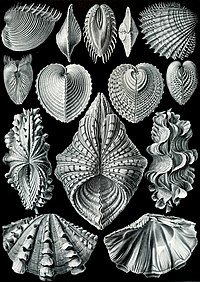
Photo from wikipedia
Abstract This paper describes the distribution of the razor clam Ensis directus in the Dutch coastal zone with emphasis on its relation to sediment grainsize, in particular silt. The study… Click to show full abstract
Abstract This paper describes the distribution of the razor clam Ensis directus in the Dutch coastal zone with emphasis on its relation to sediment grainsize, in particular silt. The study includes a spatial survey along the coast of North Holland (Netherlands) and an in-situ experiment for the burial of silt. Densities of E. directus appeared highest close to the coast in the siltiest sediment, where also the highest body mass index values (BMI) were found suggesting the best conditions for growth. The largest specimens with the lowest BMI were found at the less silty, outermost off-shore stations. In the shallow (10 m) zone a “lander” frame was deployed at the seabed containing ~ 100 pvc tubes filled with silt free sand that each hosted either a living E. directus , an empty shell, or bare sand. After three 3-weeks periods the silt content in the different tubes was determined and compared. The silt content around a living E. directus appeared 34% (spring) and 12% (autumn) higher than around an empty vertical shell, and 56% (spring) higher than in bare sand. We discuss the different pathways along which silt is brought into subsurface sediment layers and speculate about the potential role of E. directus in the coastal sediment and silt dynamics. It is estimated that E. directus facilitates the (temporal) burial of up to 6 Mton of fine particles in the coastal zone annually. This equals up to 27% of the annual SPM transport along the Dutch coast and is between 45 and 85% of the annual influx into the western Wadden Sea. The results show that the coastal E. directus population has a large impact on mass balance and behaviour of SPM, and on the ecological functioning of Dutch coastal and estuarine ecosystems.
Journal Title: Journal of Sea Research
Year Published: 2017
Link to full text (if available)
Share on Social Media: Sign Up to like & get
recommendations!